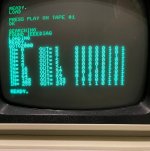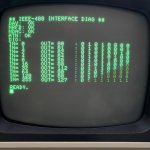FelisSapien
Member
Hi All,
I Recently acquired a PET/CBM 4016-N. It was not working on receipt but thanks to a couple of old threads on this board I've been able to get it to the BASIC prompt. On the surface everything now looks fine. Continued tinkering is revealing some quirks which I'll investigate as I'm able. My most pressing issue is that I can't read from a SD2PET device. Trying to CATALOG, LOAD or anything similar results in a ?DEVICE NOT PRESENT message. Cleaning the edge connector as suggested doesn't help so I start to search for diagnostics on the IEEE-488 port... Which lead me to another thread on this very board!
Here's what I've discovered:
The bus control lines (DAV, NFRD, NDAC and ATN) all report OK. On some further digging I find that poking values into the bus lines shows that lines 1, 3, and 4 are 'stuck' (see attached 'before' image)
Looking to the IEEE-488 I/F schematic I see a pair of MC3446 bus transceivers manage the IO lines in two groups, 1-4 (UB17) and 5-8 (UC12). Surely this is no coincidence... Testing with a logic probe I find values consistent between UB17 and UB16 (6520). Not sure what I was expecting though, I'm not a hardware guy. I decide to socket the MC3466 chips so I can swap and retest. My theory being that if UB17 was bad then the stuck bits would appear in bits 5-8. And that's what happened (see 'after' image)... my conclusion is that the chip is itself bad. Had the DIO bits remained as they were then I would have to look for something else influencing this behaviour. So... I've ordered some new chips and once they arrive we'll see if I have more joy with the SD2PET.
I've a few reasons for making this post. Firstly to get an external eye cast over what I've done. I love tinkering with old computers but am not particularly knowledgeable on hardware. I don't mind getting stuck in but I really don't know what I'm doing. There's every chance I've made a poor assumption and gone off at a tangent... To that end I really need to say thank you to dave_m, daver2, and Dwight Elvey - your work elsewhere has been immensely useful in getting this PET to behave (somewhat) as designed. I'm sure I'll be looking for your advice again sooner rather than later. Finally, it's possible that my story will be helpful to someone else?
Cheers,
Carl
I Recently acquired a PET/CBM 4016-N. It was not working on receipt but thanks to a couple of old threads on this board I've been able to get it to the BASIC prompt. On the surface everything now looks fine. Continued tinkering is revealing some quirks which I'll investigate as I'm able. My most pressing issue is that I can't read from a SD2PET device. Trying to CATALOG, LOAD or anything similar results in a ?DEVICE NOT PRESENT message. Cleaning the edge connector as suggested doesn't help so I start to search for diagnostics on the IEEE-488 port... Which lead me to another thread on this very board!
Here's what I've discovered:
The bus control lines (DAV, NFRD, NDAC and ATN) all report OK. On some further digging I find that poking values into the bus lines shows that lines 1, 3, and 4 are 'stuck' (see attached 'before' image)
Looking to the IEEE-488 I/F schematic I see a pair of MC3446 bus transceivers manage the IO lines in two groups, 1-4 (UB17) and 5-8 (UC12). Surely this is no coincidence... Testing with a logic probe I find values consistent between UB17 and UB16 (6520). Not sure what I was expecting though, I'm not a hardware guy. I decide to socket the MC3466 chips so I can swap and retest. My theory being that if UB17 was bad then the stuck bits would appear in bits 5-8. And that's what happened (see 'after' image)... my conclusion is that the chip is itself bad. Had the DIO bits remained as they were then I would have to look for something else influencing this behaviour. So... I've ordered some new chips and once they arrive we'll see if I have more joy with the SD2PET.
I've a few reasons for making this post. Firstly to get an external eye cast over what I've done. I love tinkering with old computers but am not particularly knowledgeable on hardware. I don't mind getting stuck in but I really don't know what I'm doing. There's every chance I've made a poor assumption and gone off at a tangent... To that end I really need to say thank you to dave_m, daver2, and Dwight Elvey - your work elsewhere has been immensely useful in getting this PET to behave (somewhat) as designed. I'm sure I'll be looking for your advice again sooner rather than later. Finally, it's possible that my story will be helpful to someone else?
Cheers,
Carl


